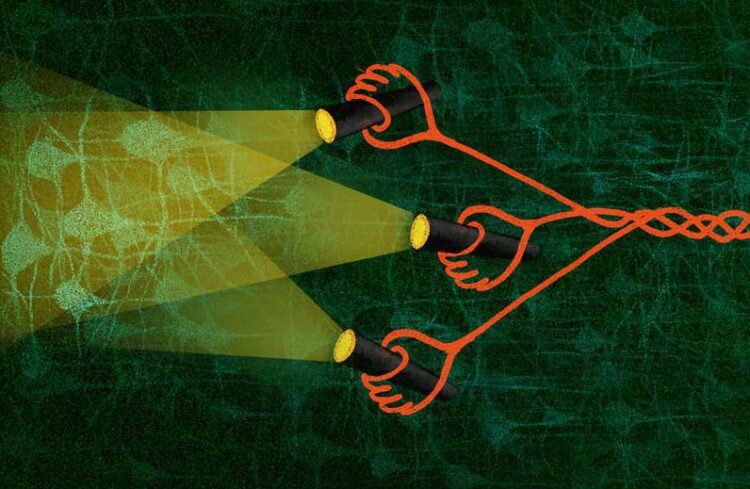How brain cells deep in the cortex operate in freely moving mice

Illustration for Nature Methods Publication "A three-photon head-mounted microscope for imaging all layers of visual cortex in freely moving mice"
Credit: Julia Kuhl
How can we see what neurons deep in the cortex are doing during behavior?
Researchers of the MPINB developed a microscope small enough to be carried on the head of a freely moving mouse and capable of measuring neuronal activity in all, even the deepest, cortical layers. The 2-gram microscope is controlled remotely, minimizing the need to handle the animal. It also incorporates new technology enabling imaging in lit environments, something that comparable microscopes struggled to do. Neuronal activity can now be imaged from all cortical layers during the full range of the animal’s behavior. This microscope is a game changer for exploring the link between neural activity and complex behavior.
How does the brain produce behavior? Studying the brain during behavior is most informative when the animal is free to interact with its environment in any way it chooses. This requires small head-mounted devices that provide access to the brain, but that do not interfere with the animal’s behavior. “We are interested in how freely behaving animals use vision to make decisions in their everyday life, and as many of the brain cells that are thought to be involved in this process are located deep in the visual cortex, we made a very light-weight head-mounted microscope that can measure activity from these neurons but does not interfere with the animal’s behavior. We have made a large step towards finally imaging brain activity deep in the cortex of animals performing natural visual-based behaviors” said Jason Kerr, director of the Department of Behavior and Brain Organization, Max Planck Institute for Neurobiology of Behavior (MPINB), Bonn, Germany.
In the study that is published today in Nature Methods, the MPINB researchers developed a miniature 2-gram three-photon excitation microscope which delivers a number of firsts. For the first time, it is now possible to image neural activity on a single-cell level from all cortical layers without having to interfere with the animal’s behavior, made possible by a remote focusing mechanism. Its modular design also offers a high-resolution configuration which allows for functional recordings from neuronal somata and dendrites. Another important feature is that, due to a modified detector system, the microscope can be used in fully lit conditions. “The robustness of our new miniature microscope to ambient light allows us to image the brain’s activity while the animal is having access to its full sensory repertoire. We can now study visually guided natural behavior like prey hunting and predator avoidance” says Alexandr Klioutchnikov, first author of the study. To confirm range and stability of the new miniature three-photon microscope, the team imaged from the deep cortical layers 4 (L4) and 6 (L6) while mice were freely exploring an arena. It turned out that L4 and L6 neurons were differentially modulated depending on the environmental light.
As the microscope can easily be mounted again at the exact same position, the same neuronal populations can be imaged in follow-up sessions spread over days. This opens up the possibility to monitor changes in the brain’s activity, for example while the animal is learning.
Wissenschaftliche Ansprechpartner:
Prof. Dr. Jason N. D. Kerr, jason.kerr@mpinb.mpg.de
Originalpublikation:
Media Contact
All latest news from the category: Life Sciences and Chemistry
Articles and reports from the Life Sciences and chemistry area deal with applied and basic research into modern biology, chemistry and human medicine.
Valuable information can be found on a range of life sciences fields including bacteriology, biochemistry, bionics, bioinformatics, biophysics, biotechnology, genetics, geobotany, human biology, marine biology, microbiology, molecular biology, cellular biology, zoology, bioinorganic chemistry, microchemistry and environmental chemistry.
Newest articles
Faster, more energy-efficient way to manufacture an industrially important chemical
Zirconium combined with silicon nitride enhances the conversion of propane — present in natural gas — needed to create in-demand plastic, polypropylene. Polypropylene is a common type of plastic found…

Energy planning in Ghana as a role model for the world
Improving the resilience of energy systems in the Global South. What criteria should we use to better plan for resilient energy systems? How do socio-economic, technical and climate change related…

Artificial blood vessels could improve heart bypass outcomes
Artificial blood vessels could improve heart bypass outcomes. 3D-printed blood vessels, which closely mimic the properties of human veins, could transform the treatment of cardiovascular diseases. Strong, flexible, gel-like tubes…




















